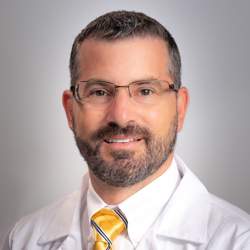Biography
Reed Selwyn, PhD, DABR is a practicing, board-certified (ABR) diagnostic medical physicist, Medical Physics Section Chief, and Executive Vice Chair of the Department of Radiology at the University of New Mexico. He has served in leadership roles in the Society of Nuclear Medicine and Molecular Imaging and in the Navy. Dr. Selwyn is a retired Naval officer who started in the Naval Reactors program and was the Training Director for Naval Nuclear Power Training Command before transferring to the Radiation Health Program. While in the Navy, Dr. Selwyn developed and directed a translational imaging facility to study traumatic brain injury, deployed to Afghanistan to install multiple MRI scanners, and served as technical advisor to the DOD for the Fukushima nuclear accident. Dr. Selwyn has received approximately $9M in DOD and NIH funding and has served on study sections for NIH, Brain Canada, Lerch Rett Foundation, Los Alamos National Laboratory, and as a Network of Experts for the FDA. Since coming to UNM in 2014, Dr. Selwyn received $1.8M S10 NIH High-End Instrumentation grant and installed the first Bruker 7T PET/MRI system in the U.S., developed and launched a Human Imaging Research Core, initiated a Medical Physics Outreach Program to provide quality services to underserved communities throughout New Mexico, and was instrumental in launching our first theranostics treatment (LUTATHERA). Dr. Selwyn has a research interest in targeted radiomicrosphere therapy for liver cancer with PET-based dosimetry and in advanced PET/MRI neuroimaging techniques for mild traumatic brain injury (mTBI).
Areas of Specialty
Specialization #1 Diagnostic Medical Physics
Specialization #2: Radioactive Microspheres
Specialization #3: Imaging of Traumatic Brain Injury (TBI)
Specialization #4: PET/MRI
Certifications
Certification #1 Diplomate American Board of Radiology
Certification #2 Diagnostic Medical Physics-Certificate
Achievements & Awards
Defense Meritorious Service Medal, 2014
5 Navy and Marine Corps Commendation Medals, 2012
2 Navy and Marine Corps Achievement Medals, 2012
Humanitarian Service Medal, and Outstanding Service Award (Uniformed Services University of the Health Sciences), 2010
American Association of Physicists in Medicine (AAPM) John R. Cameron Young Investigator Award, 2007
Radiology Chairman?s MVP award,
UNM Regent?s Professor award,
Key Publications
Journal Article
Selwyn, Reed, Nickles, R, J Thomadsen, B, R DeWerd, L, A Micka, J, A 2007 A new internal pair production branching ratio of 90Y: the development of a non-destructive assay for 90Y and 90Sr. Applied radiation and isotopes : including data, instrumentation and methods for use in agriculture, industry and medicine, vol. 65, Issue 3, 318-27
Journal Article
Byrnes, K, R Wilson, Colin, Brabazon, F, von Leden, R, Jurgens, J, S Oakes, T, R Selwyn, Reed, 2014 FDG-PET imaging in mild traumatic brain injury: a critical review. Frontiers in neuroenergetics, vol. 5
Journal Article
Brabazon, F, Wilson, Colin, Shukla, D, K Mathur, S, Jaiswal, S, Bermudez, S, Byrnes, K, R Selwyn, Reed, 2017 [18F]FDG-PET Combined with MRI Elucidates the Pathophysiology of Traumatic Brain Injury in Rats. Journal of neurotrauma, vol. 34, Issue 5, 1074-1085
Journal Article
Selwyn, Reed, Hockenbury, N, Jaiswal, S, Mathur, S, Armstrong, R, C Byrnes, K, R 2013 Mild traumatic brain injury results in depressed cerebral glucose uptake: An (18)FDG PET study. Journal of neurotrauma, vol. 30, Issue 23, 1943-53
Gender
Male
Languages
- English
Courses Taught
BIOMED 522
Medical Student Radiology Clerkship (Phase III)
Preventative Medicine Residency
Medical Physics Block
Nuclear Medicine Authorized User Course
MPHY 518
Research and Scholarship
My research is focused on developing novel radioactive microspheres for imaging and treating liver cancer, and my lab is actively developing new resin and glass microspheres in collaboration with Chemical and Biological Engineering. Overall, we are interested in developing PET-based dosimetry for pre- and post-planning treatment of radiomicrosphere therapy. In addition to liver cancer therapy, I also actively study mild traumatic brain injury (mTBI) and use PET and MR imaging techniques to detect subtle brain changes. I have developed preclinical imaging facilities for the DOD and the University of New Mexico for studying brain injury and various cancer models.
Hobson N, Polster SP, Cao Y, Flemming K, Shu Y, Huston J, Gerrard CY, Selwyn R, Mabray M, Zafar A, Girard R, Carrion-Penagos J, Fen Chen Y, Parrish T, Zhou XJ, Koenig JI, Shenkar R, Stadnik A, Koskimaki J, Dimov A, Turley D, Carroll T, Awad IA. Phantom validation of quantitative susceptibility and dynamic contrast-enhanced permeability MR sequences across instruments and sites. J Magn Reson Imaging. 2019; in press
Maphis NM, Peabody J, Crossey E, Jiang S, Jamaleddin Ahmad FA, Alvarez M, Mansoor SK, Yaney A, Yang Y, Sillerud LO, Wilson CM, Selwyn R, Brigman JL, Cannon JL, Peadbody DS, Chackerian B, Bhaskar K. QB virus-like particle-based vaccine induces robust immunity and protects against tauopathy. NPJ Vaccines. 2019;4:26.
Brocato TA, Brown-Glaberman U, Wang Z, Selwyn RG, Wilson CM, Wyckoff EF, Lomo LC, Saline JL, Hooda-Nehra A, Pasqualini R, Arap W, Brinker CJ, Cristini V. Predicting breast cancer response to neoadjuvant chemotherapy based on tumor vascular features in needle biopsies. JCI Insight. 2019 Mar 5;5.
McCart EA, Thangapazham RL, Lombardini ED, Mog SR, Panganiban RAM, Dickson KM, Mansur RA, Nagy V, Kim SY, Selwyn R, Landauer MR, Darling TN, Day RM. Accelerated senescence in skin in a murine model of radiation-induced multi-organ injury. J Radiat Res. 2017;58(5):636-646.

